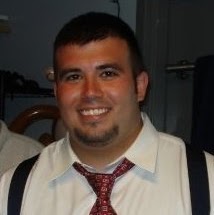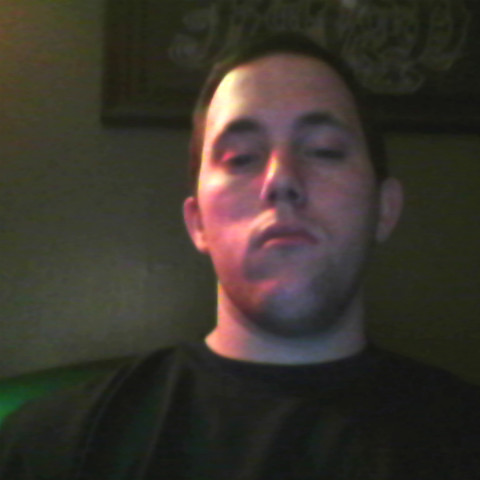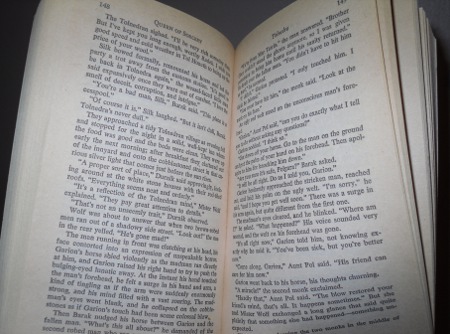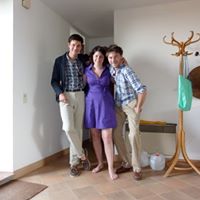Joseph E Holmes
age ~73
from Kensington, CA
- Also known as:
-
- Joseph Edward Holmes
- Joe E Holmes
- Joeseph E Holmes
- Josephe Holmes
Joseph Holmes Phones & Addresses
- Kensington, CA
- Pleasant Hill, CA
- Oakland, CA
Us Patents
-
Small-Gamut Colorant Set
view source -
US Patent:6459501, Oct 1, 2002
-
Filed:Mar 29, 1999
-
Appl. No.:09/280232
-
Inventors:Joseph Holmes - Kensington CA 94707
-
International Classification:G06F 1500
-
US Classification:358 19, 358502, 358518, 358515, 358520
-
Abstract:A small-gamut colorant set is a new system and mechanism for reproducing monochrome images on a wide range of color printing devices with an unprecedented combination of flexibility and quality. It is fundamentally unlike, and yet in certain ways similar to, both existing colorant systems for printing color images and existing colorant systems for printing monochrome images. It combines many advantages from both of these families of traditional colorant systems into a kind of system that is superior in many ways for printing monochrome images. It uses a set of at least three tinted gray colorants to create a color space within which a small amount of chroma adjustment and the full range of hue adjustment is possible. These three tinted grays may be accompanied by a black colorant, and/or other shades of gray, or a second set of three tinted grays, depending on the opportunities presented by the nature of the printing device.
-
Visual Calibration Target Set Method
view source -
US Patent:6686953, Feb 3, 2004
-
Filed:Mar 1, 2001
-
Appl. No.:09/797897
-
Inventors:Joseph Holmes - Kensington CA 94707
-
International Classification:H04N 1700
-
US Classification:348179, 348181
-
Abstract:A novel process of visual calibration of a computer display or the like in volves adjusting the appearance and relative appearance of targets and su targets displayed on the display. An objective method is provided for determining the precisely optimal brightness setting for CRT displays, which method is also applicable to the setting of the âBlack Levelâ control on some FPDs. A precise method is provided to visually determine conformity of a displays tonality to a given standard tone curve, for example a gamma 1. 8 curve, which is embodied in one of the preferred calibration target sets. The need to sense and therefore be able to control and to verify the correct gray balance of the entire tone scale of the display is met. The problem of verifying the similarity of the tone curve in the display profile and that of the actual calibration is solved. By converting a preferred RGB gamma target into CIE Lab image data through an ideal display profile of the correct gamma, a new kind of target is taught.
-
Visual Calibration Target Set Method
view source -
US Patent:RE42089, Feb 1, 2011
-
Filed:Feb 3, 2006
-
Appl. No.:11/347787
-
Inventors:Joseph Holmes - Kensington CA, US
-
International Classification:H04N 17/00
H04N 17/02 -
US Classification:348179, 348181
-
Abstract:A novel process of visual calibration of a computer display or the like in volves adjusting the appearance and relative appearance of targets and su targets displayed on the display. An objective method is provided for determining the precisely optimal brightness setting for CRT displays, which method is also applicable to the setting of the “Black Level” control on some FPDs. A precise method is provided to visually determine conformity of a display's tonality to a given standard tone curve, for example a gamma 1. 8 curve, which is embodied in one of the preferred calibration target sets. The need to sense and therefore be able to control and to verify the correct gray balance of the entire tone scale of the display is met. The problem of verifying the similarity of the tone curve in the display profile and that of the actual calibration is solved. By converting a preferred RGB gamma target into CIE Lab image data through an ideal display profile of the correct gamma, a new kind of target is taught.
-
Carrying Arrangement For Decoys And Other Objects
view source -
US Patent:46567712, Apr 14, 1987
-
Filed:Oct 29, 1985
-
Appl. No.:6/792461
-
Inventors:Joseph G. Holmes - Piedmont CA
-
International Classification:A01M 3106
-
US Classification:43 3
-
Abstract:A duck decoy or any other object (10) is made easy to pick up and carry, especially when being retrieved manually from cold water, by the present arrangement. An eyelet (12) is attached to its underside (or any other surface). A flexible line (16), such as a string, is passed through the eyelet. A weight or stop (20) is attached to one end of the line and a washer (18) or other annulus providing a loop is attached to the other end of the line. When the decoy is floating in water, the washer end of the line is at the eyelet and the weight extends down, away from the decoy. To retrieve the decoy from its floating position, it is manually grasped, lifted out of the water, and an elongated member (26) attached to a carrying handle (38) is passed through the washer. The decoy is then released, allowing it to fall to the weight at the other end of the line, whereby it will hang on the other end of the line from the elongated member and the washer, whereby it can be conveniently carried, along with a plurality of other decoys, by the elongated member with minimal manual handling.
Medicine Doctors

Joseph N. Holmes
view sourceSpecialties:
Internal Medicine
Work:
Weight To Go Carolina
221 Jake Alexander Blvd S, Salisbury, NC 28147
(704)2160227 (phone), (704)7629930 (fax)
221 Jake Alexander Blvd S, Salisbury, NC 28147
(704)2160227 (phone), (704)7629930 (fax)
Education:
Medical School
Texas Tech University Health Science Center School of Medicine - Lubbock
Graduated: 1986
Texas Tech University Health Science Center School of Medicine - Lubbock
Graduated: 1986
Conditions:
Anxiety Phobic Disorders
Attention Deficit Disorder (ADD)
Bronchial Asthma
Diabetes Mellitus (DM)
Erectile Dysfunction (ED)
Attention Deficit Disorder (ADD)
Bronchial Asthma
Diabetes Mellitus (DM)
Erectile Dysfunction (ED)
Languages:
English
Spanish
Spanish
Description:
Dr. Holmes graduated from the Texas Tech University Health Science Center School of Medicine - Lubbock in 1986. He works in Salisbury, NC and specializes in Internal Medicine.

Joseph Nathan Holmes
view sourceSpecialties:
Family Medicine
Internal Medicine
Internal Medicine
Education:
Texas Tech University(1986)
Name / Title
Company / Classification
Phones & Addresses
Managing
Accelerated Business Performance, LLC
JJD PROPERTIES LLC
HARELSONS, LLC
HERLDJJ, LLC
Owner
Natural Light Photography
Commercial Photography
Commercial Photography
14 Highland Blvd, Berkeley, CA 94707
(510)5244480
(510)5244480
Incorporator
HASSAN & HOLMES APPLIANCE SERVICE CO., INC
President
QUACKER-PACKER, INC
209 Highland Ave, Oakland, CA 94611
Wikipedia References

Joseph Holmes (Photographer)
Resumes

Joseph Holmes San Jose, CA
view sourceWork:
Northrop Grumman, Inc
San Jose, CA
Dec 2008 to May 2014
Test Engineer - System Integration and Test TFT, Inc
San Jose, CA
Mar 2003 to Dec 2008
Product Support - Emergency Alert Systems BSquare
Sunnyvale, CA
Feb 2000 to Mar 2002
Product Support - WindowsCE Hardware Reptron Electronics, Inc
San Jose, CA
Oct 1998 to Feb 2000
Field Applications Engineer TRW
Sunnyvale, CA
Jul 1982 to Oct 1998
Sr. Associate Engineer
San Jose, CA
Dec 2008 to May 2014
Test Engineer - System Integration and Test TFT, Inc
San Jose, CA
Mar 2003 to Dec 2008
Product Support - Emergency Alert Systems BSquare
Sunnyvale, CA
Feb 2000 to Mar 2002
Product Support - WindowsCE Hardware Reptron Electronics, Inc
San Jose, CA
Oct 1998 to Feb 2000
Field Applications Engineer TRW
Sunnyvale, CA
Jul 1982 to Oct 1998
Sr. Associate Engineer
Education:
Foothill College
Los Altos, CA
1989
A.S. in Electronics
Los Altos, CA
1989
A.S. in Electronics
Isbn (Books And Publications)




Lawyers & Attorneys

Joseph Henry Holmes - Lawyer
view sourceAddress:
Lamb Building
Licenses:
New York - Currently registered 2010
Education:
Nottingham
Myspace
Flickr
Googleplus

Joseph Holmes
Lived:
Redwood City, CA
Charleston, SC
Ithaca, NY
Naples, Italy
San Francisco, CA
St. Mary's, GA
Columbia, SC
Little Rock, AR
Greenville, SC
Mt. Pleasant, SC
Charleston, SC
Ithaca, NY
Naples, Italy
San Francisco, CA
St. Mary's, GA
Columbia, SC
Little Rock, AR
Greenville, SC
Mt. Pleasant, SC
Work:
United Business Media - Financial Analyst (2012)
Premier Retail Networks - Production Coordinator (2010-2012)
Premier Retail Networks - Production Coordinator (2010-2012)
Education:
San Francisco State University - Comparative Literature, University of South Carolina - Theatre, Japanese

Joseph Holmes
Work:
WinCo Foods - Grocery Clerk (6)
Education:
California State University, Chico - Computer Information Systems, Santa Rosa Junior College - Anthropology
Tagline:
Dad, Husband, Student, Wage-slave. The usual

Joseph Holmes
Work:
Clifton Gunderson LLP - Senior Associate Assurance Services (2010)
Education:
Illinois Wesleyan University - Accounting

Joseph Holmes
Work:
Me, myself and i
Education:
Los Angeles Pierce College

Joseph Holmes
Work:
EFCO, a Pella Company (2007)
About:
I enjoy reading, fishing, football, and living life with my family.

Joseph Holmes

Joseph Holmes

Joseph Holmes
News

Bo Nickal books debut fight against Jamie Pickett at UFC 282 in December
view source- As for Pickett, hell have his work cut out for him as he faces Nickal after suffering back-to-back losses in his past two fights in the UFC. Pickett currently holds a 2-4 record in the UFC with wins over Laureano Staropoli and Joseph Holmes.
- Date: Sep 29, 2022
- Category: Sports
- Source: Google
Classmates

Joseph Holmes
view sourceSchools:
St. Joseph's High School Pensacola FL 1961-1965
Community:
Michael Watts, Bertrand Schusse, Verlene Hetherington, Linda Poe

Joseph Holmes (Fallon)
view sourceSchools:
Archbald High School Archbald PA 1957-1961
Community:
Jim Monko

Joseph Holmes
view sourceSchools:
Divine Heart Preparatory Donaldson IN 1974-1978
Community:
Juan Nieves, Michael Smith, Timothy Hagedorn, Richard Leo, Larry Geinosky

Joseph Holmes
view sourceSchools:
Winamac High School Winamac IN 1966-1970

Joseph Holmes
view sourceSchools:
Aiken Christian School Aiken SC 1966-1970
Community:
Joseph Chaney, Donna Pitts, Becky Grothe, Elicia Tischhauser, Samuel Lartey

Joseph Holmes
view sourceSchools:
Lee Central High School Bishopville SC 2002-2006

Joseph Holmes
view sourceSchools:
Sarah T. Reed Sr High School New Orleans LA 2002-2006
Community:
Latasha Lawton, Noni Marks

Joseph Holmes
view sourceSchools:
Memphis Catholic High School Memphis TN 1976-1980
Community:
Jessica Bartholomew, Eula Dillashaw, Herman White, Bettye Krupchak, Annmarie Peresotti
Youtube

Joseph Holmes
view source
Joseph JoJo Holmes
view source
Joseph Juice Holmes
view source
Joseph Norman Holmes
view source
Joseph Fuauli Holmes
view source
Joseph Allen Holmes
view source
Joseph Leon Holmes
view source
Joseph P Holmes
view sourceGet Report for Joseph E Holmes from Kensington, CA, age ~73



















